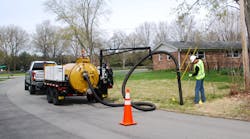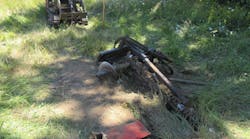Please visit our photo gallery to view pictures of this project.
Chester Creek flows through the heart of Anchorage from its headwaters high in the Chugach Mountains east of the city. Near its terminus it supplies a controlled water volume for Westchester Lagoon before flowing under a popular recreational trail and the Alaska Railroad embankment, finally emptying into Knik Arm. It is at this intersection that a $6-million habitat restoration and flood control project is taking shape while presenting unusual construction challenges.
The project took years to plan and is the work of the Municipality of Anchorage in collaboration with the Alaska Department of Fish and Game, the U.S. Fish and Wildlife Service, NOAA, and a host of other local and private organizations. With local, state and federal permits in place, the project started at the end of July 2008 with Hamilton Construction LLC of Skagway, AK, as prime contractor.
For Curt Sullivan, Hamilton's project manager, the job created distinct challenges on each side of the railroad embankment that divided the project. Tidal activity and the presence of tidelands clay were present on the ocean or west side of the railroad tracks. Maintaining access to the popular Tony Knowles Coastal Trail and the recreation area adjacent to Westchester Lagoon added to the complexity on the east side of the railroad embankment.
Tidal ranges, the difference between low and high tides, are greater in Cook Inlet than anywhere else in the United States. The Knik Arm is part of Cook Inlet, requiring Hamilton's crews to work around tide schedules and heights, specifically during construction of the wing wall at the opening of the box culvert that would pass under the railroad embankment.
"A coffer dam had to be constructed to control the water entry into the construction area and had to be rebuilt several times due to the tidal surge," Sullivan said. Tidal activity also played a role in scheduling work to install a 54-inch high density polyethylene pipe (HDPE) in an existing 84-inch culvert and extend it approximately 300 feet out into the inlet. Alaska's long hours of summer daylight were helpful in taking advantage of low tides, regardless of the time of day.
The tidal flats clay — known locally as "Bootleggers Cove Clay" — is present along much of the Anchorage shoreline. Its slippery consistency can suck in an unsuspecting person who might venture out onto the flats at low tide. Over the years it has proven fatal for the unwary on more than one occasion. It also liquefies under seismic pressure and is given as the reason for massive ground failures that destroyed one Anchorage seaside neighborhood during the Good Friday earthquake of 1964.
Running a construction project under those conditions presented another unique challenge.
"The clay that was excavated from the inlet side was like mush and created disposal problems due to its sticky makeup and the challenges that trucks faced while dumping the material," said Sullivan.
Temporary BypassOn the lagoon side of the project, a temporary bypass section was constructed that allowed for continued use of the trail during project activity. That activity included construction of a new pedestrian bridge over a fish channel, the addition of a fish-viewing platform adjacent to the bridge, and improvements to an existing weir. While there is a small wild run of Coho salmon in Chester Creek, the improvements will not increase the number of fish that pass through the area. Chester Creek, unlike some of the other creeks that bisect the Anchorage Bowl, is not open to fishing.
For Sullivan and his crew, maintaining safe access to the coastal trail during a busy construction schedule was paramount.
"During the entire project, the access to the coastal trail had to be maintained to the general public and with the movement of heavy trucks and equipment, it created quite a challenge," he said.
The project's proximity to the well-established nearby neighborhood presented yet another challenge. While some of the classified material was hauled to the site on the Alaska Railroad, much of it was trucked on site over quiet residential streets that were posted as truck routes during the project.
Sullivan credits the Municipality of Anchorage with keeping the public informed on the project and any inconveniences that might occur through the use of ads and updates at local community council meetings. "Overall the project went extremely well, with only a small number of individuals upset over the disturbance that a construction project of this size and nature would have in their front yard," Sullivan said.
Excavation for Box CulvertAt the heart of the project and linking the two sides is a 96-foot-long box culvert that required excavation of the railroad embankment for installation. The culvert is made of 32 sections that are 15 feet square and 3 feet wide. Crews used a rap pad poured at the construction management site established on municipal park land adjacent to the lagoon to form the culvert sections.
Sullivan described the culvert production system: "We poured four box culverts approximately every three days. The process was slow to start but picked up momentum once we developed a system for stripping and reconstructing the forms. With the pours completed, the Dwydag post-tensioning holes were aligned to make sure the culverts would connect in the formed keyway as intended."
Installation of the culvert sections required excavation of the railroad embankment to a depth that would accommodate the outflow from the lagoon. The Alaska Railroad gave the Hamilton crew a 96-hour window in which to remove the single track, excavate the embankment, install and secure the culvert sections, and return the embankment and track to operation.
Performance on that part of the project exceeded Sullivan's expectations. The box culverts were hauled with a Volvo 320 Loader to a Link Belt telescoping crawler crane, where they were rigged and walked into place.
"We went into the project thinking that we would work 24 hours a day during the installation," Sullivan said. "Due to pre-assembly efforts and effectiveness of the installation crew, we found it unnecessary to work a night shift." The track was returned to full service 12 hours ahead of schedule.
The project finished the 2008 construction season at the end of November, ahead of schedule. The contractual completion date is November 2009, but Sullivan said a majority of the work is done.
"We will return in the spring to place asphalt on the pedestrian bridge and approaches, conduct landscaping and remove our temporary access routes, which are expected to be complete in June 2009," he said.
Hamilton worked the project with a seven-man crew, utilizing additional help during the box culvert installation. Subcontractors provided trucking, concrete pumping, concrete cutting, and traffic control services.
While the public saw the work going on in and around a well-used park and trail system at Westchester Lagoon, they probably did not know of the unique challenges met by the contractor. For that success, Sullivan credits his crew.
"Their inventiveness and intuitive nature are an attribute to the success of the project," he said.
| Author Information |
| Gene Storm, an Anchorage freelance writer and photographer, has covered Alaska construction projects for PB&E for nearly 20 years. |




